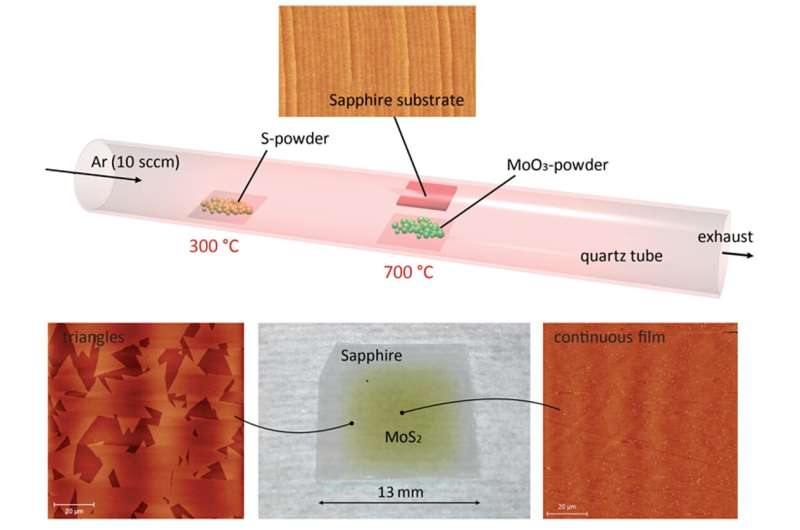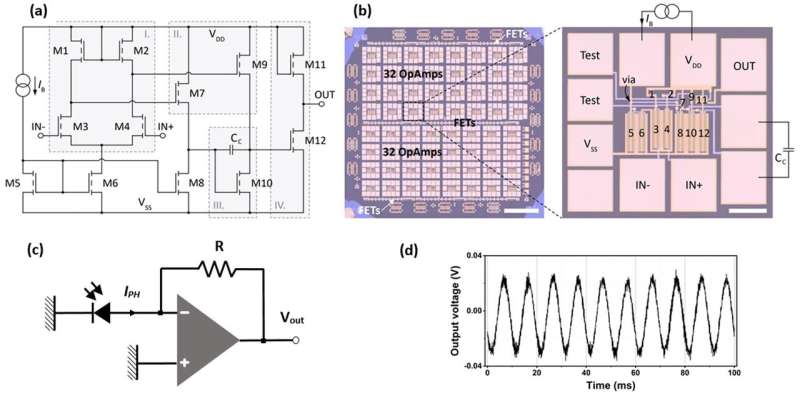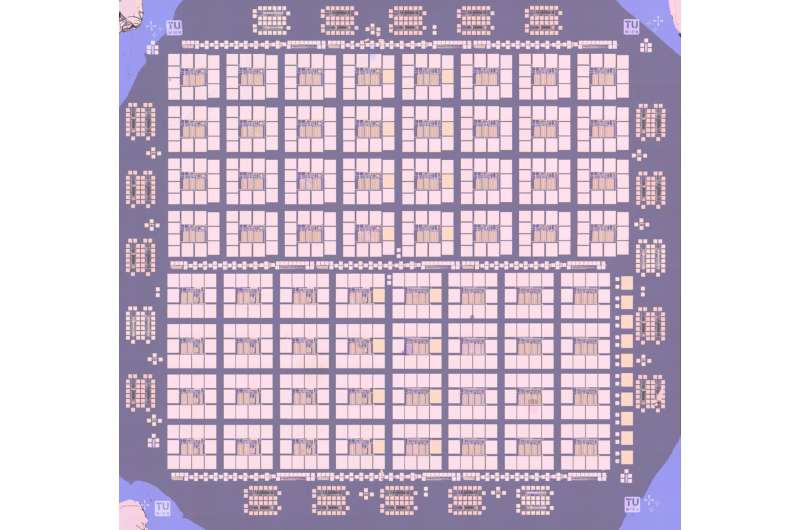September 14, 2020 feature
An operational amplifier fabricated using a 2-D semiconductor

Analog electronics are electronic systems that operate with currents and voltages that continuously change over time, rather than switching only between two levels, like digital electronics. Most existing analog devices are made of silicon. Due to the pressing demand for electronics that can be integrated within a wide range of devices, however, researchers have recently started exploring the possibility of fabricating analog components using alternative materials.
One class of materials that have proved to be particularly promising for the development of analog electronics are 2-D semiconducting transition metal dichalcogenides (TMDs), such as molybdenum disulphide (MoS2). In fact, these materials have a number of advantageous properties, including great electrostatic control, considerable mechanical flexibility and an intrinsic thinness.
Researchers at Vienna University of Technology, University of Pisa and AMO GmbH have recently fabricated an analog operational amplifier using the 2-D semiconductor MoS2. Their paper, published in Nature Electronics, confirms the advantages of 2-D semiconductors over silicon for the development of analog electronics.
"After we successfully demonstrated a 2-D microprocessor a few years ago, we wanted to expand our research into 2-D electronics and found that the area of analog electronics with 2-D semiconductors is still poorly covered," Dmitry K. Polyushkin, one of the researchers who carried out the study, told TechXplore. "While many people have heard about digital electronics, its counterpart, analog electronics, is overshadowed in modern research. However, many electronic devices contain numerous analog components."

The key objective of the study carried out by Polyushkin and his colleagues was to fabricate an operational amplifier, the basic building block of analog electronic devices, using a 2-D semiconductor. Subsequently, the researchers planned to test the potential and performance of this semiconductor-based amplifier by using it to build a variety of different analog circuits.
The new amplifier they created is based on locally back-gated n-channel MoS2 field-effect transistors. Remarkably, it is one of the most complex and sophisticated analog circuits based on 2-D semiconductors developed so far.
"When we started our research on 2-D analog electronics, there were only a few attempts reported in literature demonstrating analog devices," Polyushkin said. "Our goal was to realize a fully operational amplifier and based on it build different types of the analog circuits. The biggest challenge here was the stability of the circuit components."
In contrast with digital electronic devices, analog devices require highly stable and reproducible parameters for each individual element within their circuit. This can be very difficult to achieve using traditional 2-D transistors, as they are known to be very sensitive to changes in the parameters related to a circuit's different elements (e.g. oxide parameters, doping level, etc.). The researchers tried to circumvent these issues by leveraging the advantageous properties of the material they used.

"To reduce device-to-device variability, we took extra care during the fabrication process," Polyushkin said. "Thanks to the uniform CVD grown MoS2 film, we managed to achieve excellent performance of the single transistors with small hysteresis, ON/OFF ratios exceeding 8 orders of magnitude and mobility up to almost 20 cm2/Vs. The assessment of more than 40 devices showed a good reproducibility with small variations of the threshold voltage and the charge carrier mobility. This remarkable performance allowed us to combine the transistors into a 4-stage amplifier with total gain of 43 dB, in good agreement with the modeling."
In the evaluations carried out by Polyushkin and his colleagues, their operational amplifier achieved a high frequency operation, with a unity-gain frequency of 0.3 MHz. To further demonstrate its potential and applicability, the researchers used the amplifier to fabricate a number of feedback circuits that are typically used to build electronics, including an inverting amplifier, an integrator, a logarithmic amplifier and a transimpedance amplifier.
"One of the applications we used opamp for is the transimpedance amplifier, an electronic component that converts the current of an illuminated photodiode to an output voltage," Polyushkin said. "Our results nicely show the characteristic 100 Hz blinking of the classic incandescent bulb used as a light source in the measurement."
Overall, the results gathered by this team of researchers demonstrate the advantages of the operational amplifier they fabricated over similar silicon-based electronic components, while also showing that it could be suitable for a wider range of applications. While the amplifier is still a prototype and its parameters need to be improved for it to be implemented in real-world settings, the analyses carried out by Polyushkin and his colleagues suggest that manufacturing it at an industrial scale is feasible.
"2-D materials possess many advantageous properties which allow to realize components, which are almost impossible with standard silicon technology, such as flexible and transparent electronics, to name a few," Polyushkin said. "However, so far most 2-D electronics have been realized on rigid substrates. To fully realize the potential of 2-D materials one has to implement it on flexible and transparent surfaces. We believe that this will be the next challenge to overcome to enable practical applications in the field of 2-D electronics."
More information: Dmitry K. Polyushkin et al. Analogue two-dimensional semiconductor electronics, Nature Electronics (2020). DOI: 10.1038/s41928-020-0460-6
© 2020 Science X Network















